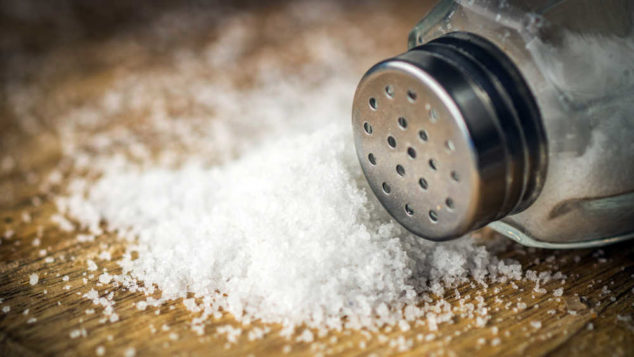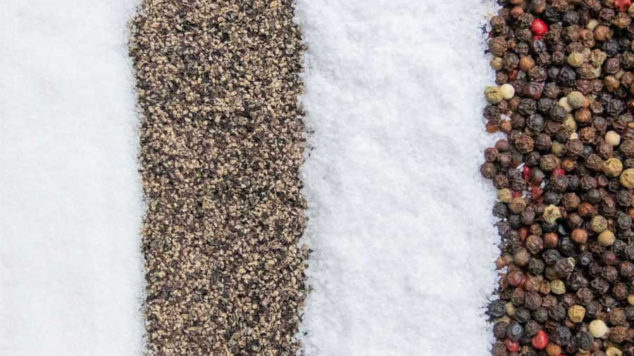Can Dogs Eat Salt and Pepper?

Have you ever noticed your dog eating salty foods that you cook? They might even get into your bag of chips when you’re not looking. Is this safe?
If you have ever wondered if dogs can eat salt and pepper, then keep reading. I’ll take a closer look at both spices and answer how safe they are for your pet.

You should avoid giving your dog too much salt. Since it’s tough to know how much is too much, the safest idea is to not give your dog any foods with any added salt at all.
Not only will too much salt make your dog really thirsty, but it could lead to sodium ion poisoning too.
Anything more than 1.5 grams per pound of body weight is considered a lethal dose of salt.
According Dr. Tim Watson BVM&S, PhD, MRCVS, “Adult dogs require a daily sodium intake of around 13 mg/kg body weight, which corresponds to a minimum dietary level of 0.2 g/1000 kcal. Requirements are 2-3 times higher in puppies and during pregnancy and lactation, and five times higher in very highly active dogs such as greyhounds or sled dogs.”
Yes, all dogs need sodium in their diets, they just don’t need very much. Refer to the amounts listed above. You shouldn’t have to do any math, however. If you feed your pet pre-made dog food, it already has the perfect amount of sodium in it.
If your dog got into a few salt packets or ate some human food that has lots of salt in it, you should give your dog plenty of water to drink.
If your dog ate lots of salt it will probably cause them to vomit, which will prevent them from getting poisoned.
Keep a close eye on your dog. If they didn’t vomit on their own and you know they ate way too much salt, then you should induce vomiting and call your veterinarian right away.
Watch out for signs of salt poisoning in your dog. If they ate too much salt, it will throw off the normal salt levels in the blood. This could cause hypertension and affect how the kidneys function.
Signs of salt poisoning include:
Do not wait to see if the worst is over. If you think your dog is suffering from salt poisoning, contact your veterinarian right away. They will be able to give care to your dog that you can’t do at home.

Black pepper is safe for your dog to eat as long as you regulate the amount. That means if they eat something that has a little bit of pepper in it, they should be fine, but they shouldn’t munch on a pile of black pepper.
Too much black pepper can cause a range of uncomfortable side effects in your dog. While it isn’t toxic, it can make your dog feel pretty bad. Watch out for these reactions if you think your dog got into too much pepper:
If you notice that your dog got into way too much pepper and they are having a tough time breathing, call your vet immediately.
Black pepper and peppercorns are the same thing. It is safe for your dog to eat a mild amount of it, but too much can cause the issues listed earlier.
Avoid letting your dog eat peppercorns alone.

Symptoms of Salt Poisoning in Dogs
There are many signs of salt poisoning in dogs, which may be neurological, gastrointestinal, or even cardiovascular. The most common signs are extreme thirst and urination, which are what may save your dog’s life if there is plenty of fresh water to drink. This is because the water dilutes the salt in the blood, and it is cleansed from the body in the urine. The signs of salt poisoning most often reported are:
Treatment of Salt Poisoning in Dogs
Your dog will likely be admitted to the hospital for oxygen, IV fluid therapy, and electrolytes to manage dehydration. The salt level will have to be brought down gradually because a sudden change in sodium levels can cause a heart attack or cerebral edema (brain swelling). It can take days to bring the levels down to an acceptable range depending on how high your dog’s sodium levels are. If cerebral edema is already present, your dog may be given a medication such as dexamethasone or mannitol to reduce the inflammation. The veterinarian will most likely keep your dog in the hospital for observation. Curious about which health plan is right for your dog? Head over to Forbes breakdown of the best pet insurance providers.
Worried about the cost of Salt Poisoning treatment?
Pet Insurance covers the cost of many common pet health conditions. Prepare for the unexpected by getting a quote from top pet insurance providers.